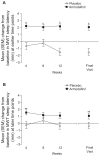Armodafinil in the treatment of sleep/wake disorders
- PMID: 20856606
- PMCID: PMC2938291
- DOI: 10.2147/ndt.s3004
Armodafinil in the treatment of sleep/wake disorders
Abstract
Excessive sleepiness (ES) is a major but underestimated public health concern associated with significant impairments in alertness/wakefulness and significant morbidity. The term ES has been used in the sleep medicine literature for years, but due to its nonspecific symptoms (ie tiredness or fatigue), it frequently goes unrecognized or is misdiagnosed in primary care. In some cases ES arises due to poor sleep habits or self-imposed sleep deprivation; however, ES is also a key component of a number of sleep/wake disorders and multiple medical and psychiatric disorders. Identification and treatment of ES is critical to improve the quality of life and well-being of patients and for the safety of the wider community. The inability of patients to recognize the nature, extent, and symptomatic profile of sleep/wake disorders requires vigilance on the part of healthcare professionals. Interventions to address ES and its associated impairments, treatment of the underlying sleep/wake disorder, and follow-up are a priority given the potential for serious consequences if left untreated. Wakefulness-promoting agents are available that treat ES associated with sleep/wake disorders. This review examines current approaches for managing this debilitating and potentially life-threatening condition, focusing on the place of armodafinil as a wakefulness-promoting agent.
Keywords: armodafinil; excessive sleepiness; narcolepsy; obstructive sleep apnea; shift-work disorder; wakefulness.
Figures



References
-
- American Academy of Sleep Medicine. Diagnostic and Coding Manual. 2nd Edition. Westchester, IL: American Academy of Sleep Medicine; 2005. International Classification of Sleep Disorders.
-
- Drake CL, Roehrs T, Richardson G, Walsh JK, Roth T. Shift work sleep disorder: prevalence and consequences beyond that of symptomatic day workers. Sleep. 2004;27(8):1453–1462. - PubMed
-
- Horstmann S, Hess CW, Bassetti C, Gugger M, Mathis J. Sleepiness-related accidents in sleep apnea patients. Sleep. 2000;23(3):383–389. - PubMed
-
- Kingshott RN, Cowan JO, Jones DR, et al. The role of sleep-disordered breathing, daytime sleepiness, and impaired performance in motor vehicle crashes – a case control study. Sleep Breath. 2004;8(2):61–72. - PubMed
-
- Lindberg E, Carter N, Gislason T, Janson C. Role of snoring and daytime sleepiness in occupational accidents. Am J Respir Crit Care Med. 2001;164(11):2031–2035. - PubMed
LinkOut - more resources
Full Text Sources

